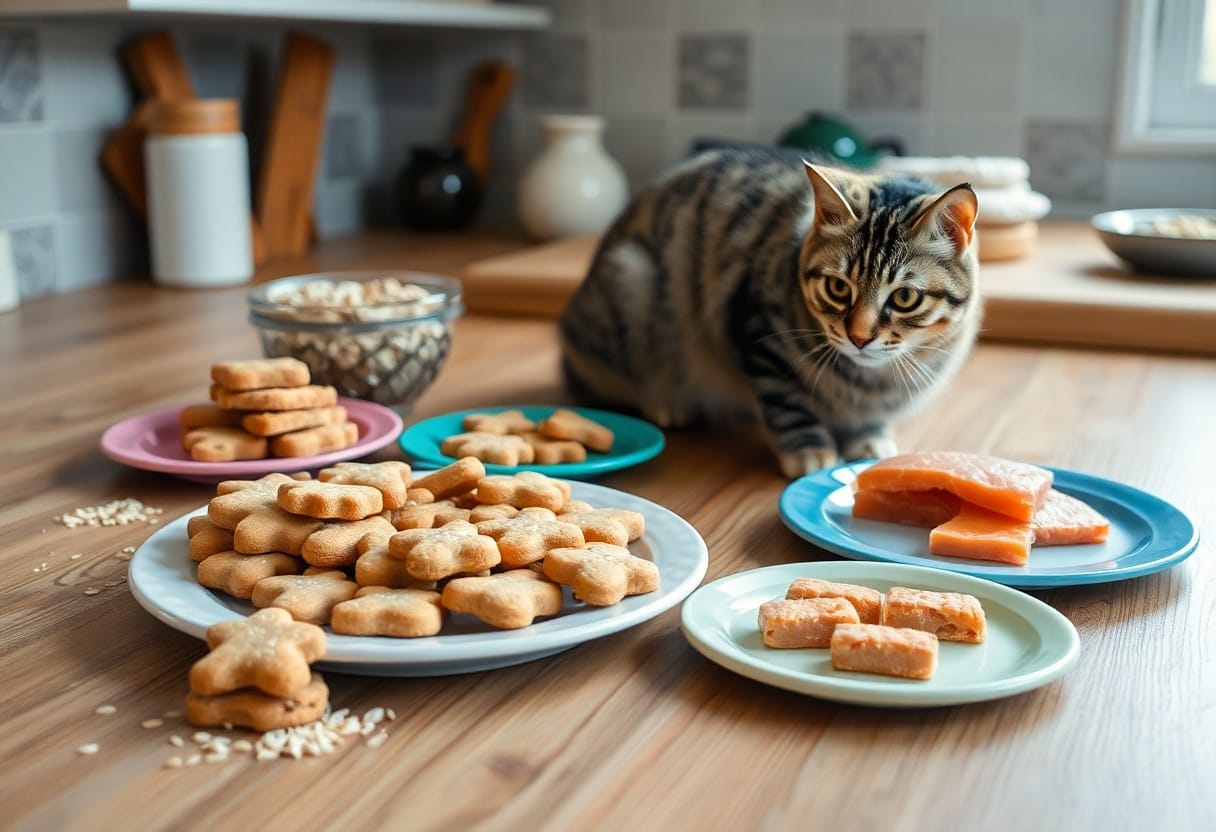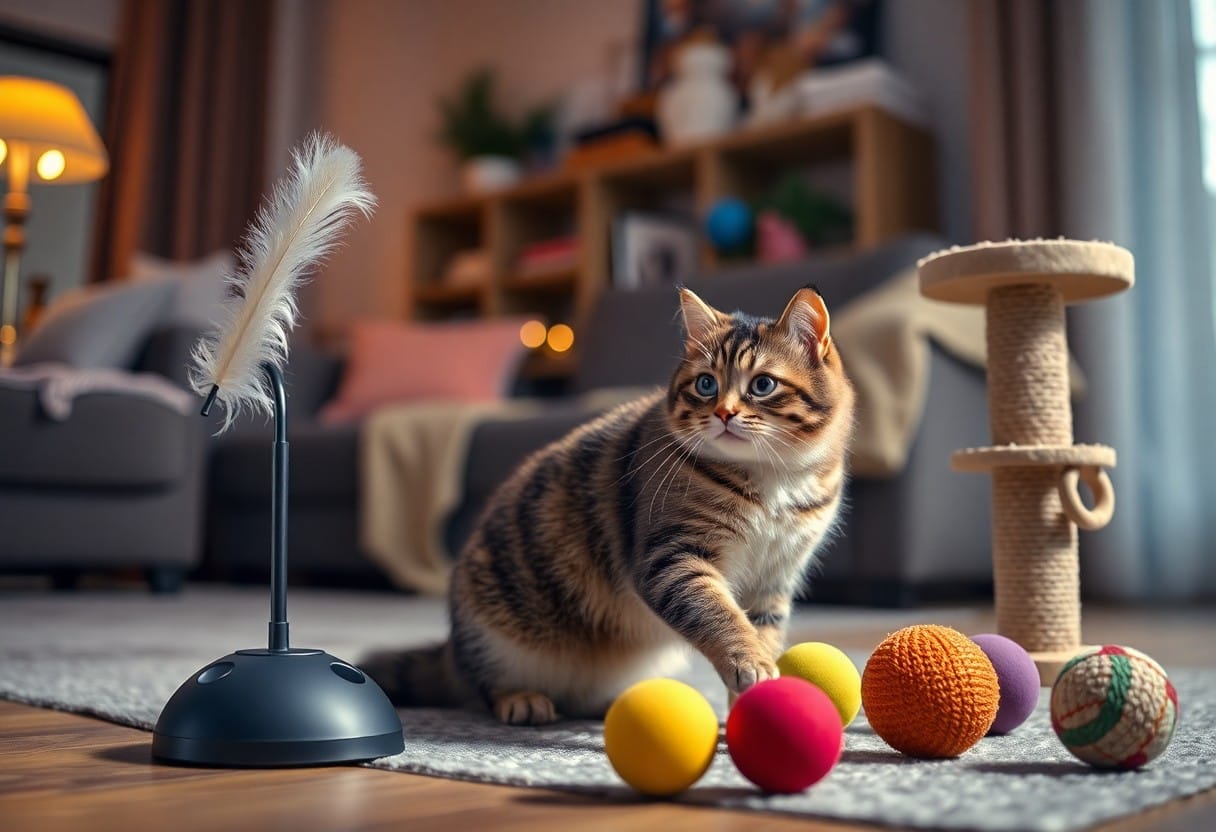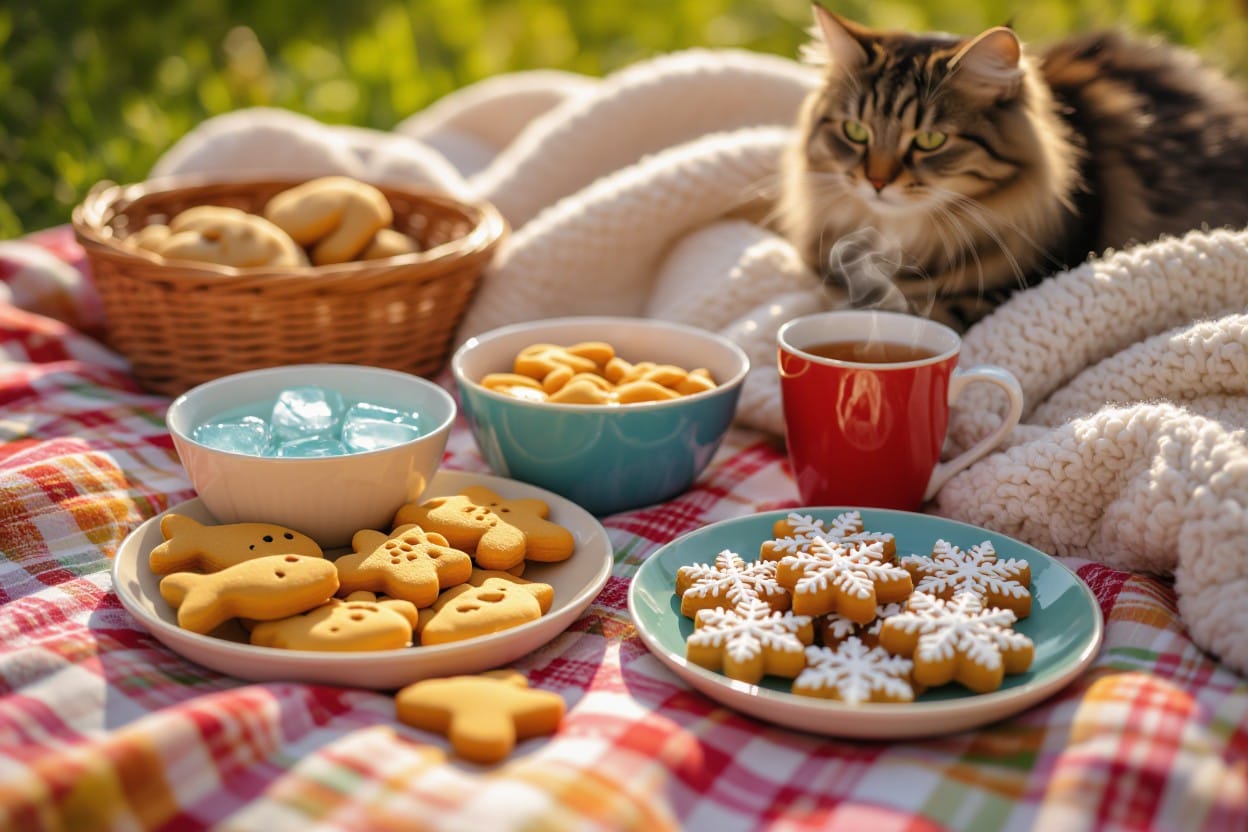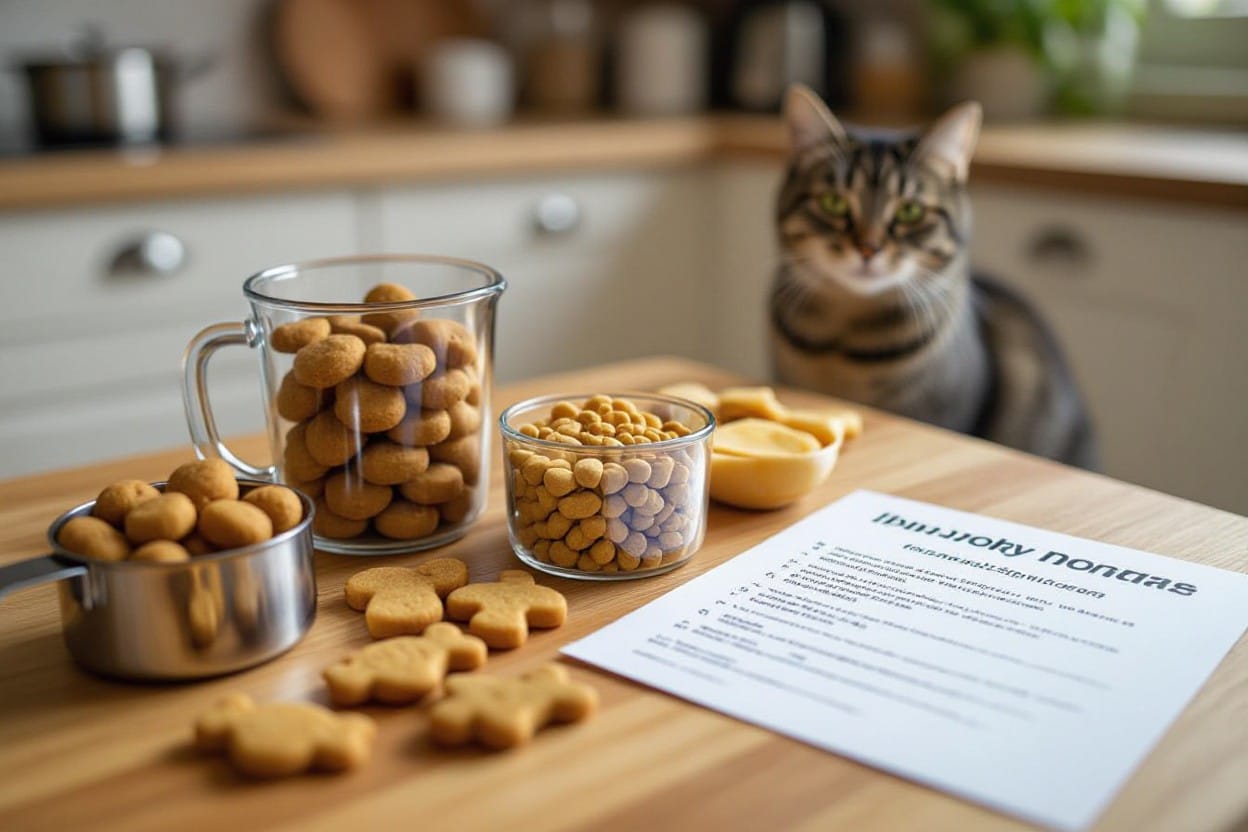Recipes for healthy homemade cat treats can transform your feline friend’s diet, offering nutritional benefits while satisfying their cravings. With the right ingredients, you can create delicious snacks that are free from harmful additives often found in commercial treats. This guide will provide you with a variety of recipes tailored for every cat lover, ensuring that you find the perfect treat to keep your kitty happy and healthy. Get ready to delight your furry companion with homemade goodness that will have them purring for more!
Key Takeaways:
- Homemade cat treats can be nutritious and tailored to your cat’s dietary needs, ensuring they receive optimal health benefits.
- The guide offers a variety of recipes, catering to different tastes and preferences, making it easy for cat lovers to spoil their pets with healthy options.
- Using natural ingredients not only helps avoid harmful additives found in store-bought treats but also allows for creativity in cooking for your feline friend.
The Nutritional Science of Feline Health
The delicate balance of nutrients in your cat’s diet is a cornerstone of their overall wellbeing. To promote a healthy lifestyle, you should focus on the specific dietary needs of your feline friend. Understanding how nutrients work together can help guide your choices when creating homemade cat treats. By incorporating the right combinations of proteins, carbohydrates, fats, vitamins, and minerals, you can ensure your furry companion thrives and maintains a healthy weight.
Key Ingredients for Cat Treats
Choosing the right ingredients is foundational when making homemade cat treats. Lean meats such as chicken, turkey, and fish provide high-quality protein, which is vital for muscle development. Adding cat-friendly vegetables like pumpkin and spinach can boost fiber intake, aiding digestion. Furthermore, incorporating healthy fats, such as fish oil, can promote a shiny coat and improved skin health. Ultimately, select ingredients that reinforce your cat’s nutritional needs while satisfying their taste preferences.
Essential Nutrients for Optimal Cat Wellbeing
Essential nutrients for your cat’s wellbeing include proteins, vital fatty acids, vitamins, and minerals. Protein is key; it supports muscle growth and repair. Essential fatty acids, primarily omega-3 and omega-6, promote a healthy coat and help regulate inflammation. Varying vitamins, like A, D, E, and B-complex, play critical roles in metabolic functions and immune health. Key minerals such as calcium and phosphorus are vital for bone health. Tailoring your treats to include these nutrients ensures your cat receives a well-rounded diet and maintains optimal health.
Crafting Treats with Natural Ingredients
Using natural ingredients in homemade cat treats not only enhances flavor but also contributes to your cat’s overall health. Whole foods like meat, vegetables, and grains pack a nutritional punch that processed ingredients lack. By crafting treats from scratch, you control what goes into each bite, ensuring optimal ingredients that cater to your feline’s specific dietary needs. Say goodbye to artificial additives and preservatives, and embrace simple, wholesome recipes that nourish your cat’s body and delight their palate.
The Benefits of Whole Foods for Cats
Whole foods provide an array of necessary nutrients that support your cat’s immune system, digestion, and energy levels. Ingredients like chicken, fish, or pumpkin can be beneficial for digestive health, while vitamins and minerals from fresh vegetables enhance overall well-being. The right combination can lead to a shinier coat, improved digestion, and a happier cat.
Simple Substitutes for Common Ingredients
If you find yourself out of a particular ingredient, there are always simpler alternatives available that will still provide the nutrition your cat needs. For example, if you don’t have oat flour, you can grind rolled oats into a fine powder. Similarly, when you’re short on chicken broth, using water infused with cat-friendly herbs like catnip can provide the necessary moisture while adding extra flavor. Ultimately, experimentation will help you discover unique combos your feline will adore.
Substituting ingredients doesn’t only offer flexibility but also opens up opportunities to personalize your cat’s treats. For instance, if your cat has a sensitivity to potatoes, you might try sweet potatoes instead; they’re nutrient-dense and also popular among many cats. Likewise, if you lack fish oil, a bit of flaxseed oil can serve as a healthy alternative. Keeping your pantry stocked with cat-friendly staples allows for spontaneity in treat-making, ensuring variety while catering to any specific dietary restrictions your cat may have.

Pawsitively Delicious Recipes for Every Occasion
Discovering the joy of making homemade cat treats opens a world of flavors and benefits for your feline friend. Whether it’s for celebrating birthdays, rewarding good behavior, or simply showing affection, these recipes cater to all occasions. Each variation brings unique ingredients and nutritional perks to the table, ensuring that you can whip up something special for your furry companion any day of the week.
Treats for Kittens: Tender Bites for Tiny Teeth
Kittens have specific dietary needs and often require softer treats that match their developing teeth and digestive systems. Opt for recipes that incorporate poultry purees or fish flakes, blended with finely ground oats or rice, ensuring they are both nutritious and easy to chew. Your little furball will love the flavors, and you’ll be confident in their healthy growth!
Gourmet Snacks for Adult Cats: Elevating Mealtime
Adult cats deserve sophisticated flavors designed to please their more discerning palates. Incorporate ingredients like chicken liver, tuna, and spinach into homemade snacks that are rich in protein and necessary vitamins. These treats not only tantalize taste buds but can also be beneficial for overall health, serving as an enticing way to encourage your kitty to enjoy mealtime.
Consider recipes that include natural goodies like catnip and pumpkin puree, which helps with digestion. You might make a decadent tuna and pumpkin pie treat shaped into dainty bites, offering both nourishment and culinary flair. Elevate your adult cat’s mealtime with snacks that mirror gourmet restaurant quality, turning simple routines into cherished moments of indulgence.
Tailoring Treats to Specific Health Needs
Adjusting homemade treats to meet your cat’s specific health needs can greatly enhance their quality of life. Whether your feline is battling obesity, experiencing digestive issues, or requires special nutrients, choosing the right ingredients ensures you’re providing support while satisfying their taste buds. Tailoring treats is not just beneficial for health but also shows how much you care for your cat’s well-being.
Low-Calorie Options for Weight Management
Low-calorie treats are important for maintaining a healthy weight in cats prone to obesity. Opt for ingredients like shredded chicken breast or carrots, which provide flavor without excessive calories. You can create crunchy bites using whole grain oats and pumpkin puree—both wholesome and low in fat. These options help you keep your cat satisfied while adhering to their dietary goals.
Treats for Sensitive Stomachs: Digestive Health Focus
Crafting treats for cats with sensitive stomachs involves selecting easily digestible ingredients like rice flour, pumpkin, or sweet potatoes. These ingredients not only soothe digestive upset but also offer additional fiber, promoting healthy bowel movements. Avoid additives and preservatives, opting instead for homemade goodness that aligns with your cat’s health needs, ensuring they can enjoy their treats without discomfort.
For those cats with sensitive stomachs, consider treats like pumpkin and yogurt biscuits. Pumpkin is high in fiber, which can help regulate your cat’s digestive system, while plain yogurt contains probiotics that promote gut health. A simple recipe could involve mixing ripe pumpkin puree with oat flour and a few tablespoons of yogurt—baking them until golden. This combination not only assists in digestion but also provides important hydration, especially beneficial during hot months. Tailor flavors to your cat’s liking, experimenting with small batches to find the perfect recipe for a happy, healthy tummy.
The Art of Treat Storage and Preservation
Storing and preserving your homemade cat treats is vital for maintaining their quality and keeping your furry friend safe from spoilage. Proper storage techniques not only extend the shelf life of treats but also ensure they retain their taste and nutritional value. From airtight containers to refrigeration, understanding the best practices for treat storage will help you provide your cat with fresh, safe, and delicious snacks every time.
Best Practices for Freshness and Longevity
To keep your homemade cat treats fresh, use airtight containers made from glass or BPA-free plastic. Store these containers in cool, dark places, like a pantry or cupboard, to minimize exposure to light and heat. Refrigeration can also be beneficial for homemade treats with moist ingredients, as it can extend freshness by up to two weeks. For longer storage, consider freezing treats in small batches, which can prolong their quality for several months.
Recognizing Signs of Spoilage and Unsafe Treats
Checking your homemade cat treats for spoilage is crucial for your pet’s health. Look out for off smells, discoloration, or unusual texture. Mold is a clear indicator that a treat should be discarded, as it can be toxic to cats. Additionally, if treats have been stored for over a month without refrigeration or freezing, it’s wise to err on the side of caution and replace them with fresh batches. Regularly inspecting your treats helps ensure a safe and enjoyable snacking experience for your cat.
Your cat’s health and safety depend on being vigilant about the signs of spoilage. For instance, if you notice a grainy texture or an odd odor coming from the treat, those are sure signs it should not be fed to your pet. The visual inspection is equally important—discoloration and visible mold indicate that potential bacteria or toxins are developing, which can lead to serious health issues. Always prioritize your cat’s wellbeing by keeping treats fresh and discarding any questionable ones promptly.
To wrap up
Ultimately, The Ultimate Guide To Healthy Homemade Cat Treats – Recipes For Every Cat Lover empowers you to create nutritious and delicious snacks for your feline friend. By using simple ingredients and following the easy-to-follow recipes, you can enhance your cat’s diet while indulging their taste buds. You’ll not only bond with your pet through the joy of homemade treats but also ensure they receive the health benefits they deserve. Enjoy the journey of crafting these delightful goodies and watch your cat thrive with every bite.
FAQ
Q: What types of ingredients are commonly used in homemade cat treats?
A: When making healthy homemade cat treats, common ingredients include lean meats such as chicken, turkey, or fish, which provide crucial protein. Additionally, cat-friendly vegetables like pumpkin or carrots can add nutritional value and fiber. Other ingredients often include eggs for binding and added protein, and oat flour or whole wheat flour as a base for texture. Always ensure that any ingredients used are safe for cats and avoid harmful items like onions or garlic.
Q: How can I ensure that the homemade cat treats are healthy for my pet?
A: To ensure that your homemade cat treats are healthy, focus on using high-quality and natural ingredients. Avoid preservatives and additives that may be harmful to your cat. It’s also advisable to keep the treats balanced by not exceeding the recommended amount of treats in your cat’s diet, which is typically about 10% of their daily caloric intake. Consulting with your veterinarian before introducing new recipes or ingredients can offer additional peace of mind regarding your cat’s specific dietary needs.
Q: Can I customize the recipes based on my cat’s preferences or dietary restrictions?
A: Absolutely! One of the advantages of making homemade cat treats is the ability to customize them to suit your cat’s taste preferences and dietary restrictions. If your cat has allergies or sensitivities, you can omit certain ingredients and replace them with alternatives that your cat enjoys. Experimenting with different protein sources or flavors can help you find the perfect treat that your cat loves. Just be sure to avoid any toxic ingredients and keep the treats nutritionally balanced.
















